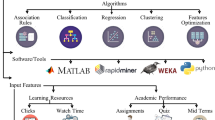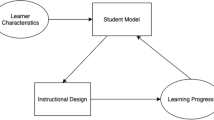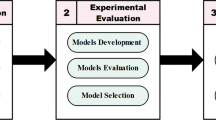Abstract
The learning style of a learner is an important parameter in his learning process. Therefore, learning styles should be considered in the design, development, and implementation of e-learning environments to increase learners’ performance. Thus, it is important to be able to automatically determine learning styles of learners in an e-learning environment. In this paper, we propose a sequential pattern mining approach to extract frequent sequential behavior patterns, which can separate learners with different learning styles. In this research, in order to recognize learners’ learning styles, system uses the Myers-Briggs Type Indicator’s (MBTI). The approach has been implemented and tested in an e-learning environment and the results show that learning styles of learners can be predicted with high accuracy. We show that learners with similar learning styles have similar sequential behavior patterns in interaction with an e-learning environment. A lot of frequent sequential behavior patterns were extracted which some of them have a meaningful relation with MBTI dimensions.




Similar content being viewed by others
References
Ahmad, N., Tasir, Z., Kasim, J., & Sahat, H. (2013). Automatic detection of learning styles in learning management systems by using literature-based method. Procedia - Social and Behavioral Sciences, 103, 181–189.
Anderson, T. (Ed.). (2008). The theory and practice of online learning. Athabasca: Athabasca University Press, Canada.
Antunes, C., & Oliveira, A. L. (2004). Sequential pattern mining algorithms: trade-offs between speed and memory.
Arkorful, V., & Abaidoo, N. (2015). The role of e-learning, advantages and disadvantages of its adoption in higher education. International Journal of Instructional Technology and Distance Learning, 12(1), 29–42.
Chu, K. C., Wang, C. S., & Kuo, J. H. (2016). Mining of learning interaction patterns in MOOCs forums. In Information reuse and integration (IRI), 2016 I.E. 17th international conference on (pp. 631–637). IEEE, Pittsburgh, PA, USA.
Coffield, F., Moseley, D., Hall, E., & Ecclestone, K. (2004). Learning styles and pedagogy in post-16 learning: A systematic and critical review.
Dewar, T., & Whittington, D. (2000). Online learners and their learning strategies. Journal of Educational Computing Research, 23(4), 385–403.
Durling, D., Cross, N., & Johnson, J. (1996). Personality and learning preferences of students in design and design-related disciplines. IDATER 96 2–4 September, Loughborough University, Loughborough.
El Bachari, E., Abdelwahed, E., & El Adnani, M. (2010). Design of an adaptive e-learning model based on learner’s personality. Ubiquitous Computing and Communication Journal, 5(3), 1–8.
Fatahi, S., Moradi, H., & Farmad, E. (2015). Behavioral feature extraction to determine learning styles in e-learning environments. International Association for Development of the Information Society. MCCSIS 2015 is multi conference on computer science and information systems. It held on Las Palmas de Gran Canaria, Spain, 21-214 July 2015.
Felder, R. M., & Silverman, L. K. (1988). Learning and teaching styles in engineering education. Engineering Education, 78(7), 674–681.
Feldman, J., Monteserin, A., & Amandi, A. (2015). Automatic detection of learning styles: state of the art. Artificial Intelligence Review, 44(2), 157–186.
Graf, S., & Liu, T. C. (2010). Analysis of learners' navigational behaviour and their learning styles in an online course. Journal of Computer Assisted Learning, 26(2), 116–131.
Guerra, J., Sahebi, S., Lin, Y. R., & Brusilovsky, P. (2014). The problem solving genome: Analyzing sequential patterns of student work with parameterized exercises. In Proceedings of the 7th International Conference on Educational Data Mining (EDM 2014) (pp 153-160).
Hall, E., & Moseley, D. (2005). Is there a role for learning styles in personalised education and training? International Journal of Lifelong Education, 24(3), 243–255.
Hammer, A. L. (1996). MBTI applications: A decade of research on the Myers-Briggs Type Indicator. Consulting Psychologists Press.
Haron, N. B., & Salim, N. B. (2006). Empirical evaluation of mixed approach in adaptive hypermedia learning system. In Proceedings of the postgraduate annual research seminar (pp. 244e249). http://eprints.utm.my/3346/1/Empirical_ Evaluation_of_Mixed_Approach_in_Adaptive_Hypermedia.pdf.
Honey, P., & Mumford, A. (1986). Using our learning styles. Berkshire: Peter Honey.
Jong, B. S., Lai, C. H., Hsia, Y. T., Lin, T. W., & Lu, C. Y. (2013). Using game-based cooperative learning to improve learning motivation: A study of online game use in an operating systems course. IEEE Transactions on Education, 56(2), 183–190.
Keefe, J. W. (1979). Learning styles: An overview. Student learning styles. Diagnosing and prescribing programs. Reston: National Association of Secondary School Principals.
Kim, J., Lee, A., & Ryu, H. (2013). Personality and its effects on learning performance: Design guidelines for an adaptive e-learning system based on a user model. International Journal of Industrial Ergonomics, 43(5), 450–461.
Kinnebrew, J. S., Loretz, K. M., & Biswas, G. (2013). A contextualized, differential sequence mining method to derive students' learning behavior patterns. JEDM-Journal of Educational Data Mining, 5(1), 190–219.
Kinnebrew, J. S., Mack, D. L., Biswas, G., & Chang, C. K. (2014). A differential approach for identifying important student learning behavior patterns with evolving usage over time. In Pacific-Asia conference on knowledge discovery and data mining (pp. 281–292). Cham: Springer.
Kolb, D. A., (1985). Learning style inventory. The Power of the 2, 2, p. 267.
Lang, H., Stinson, M., Kavanagh, F., Liu, Y., & Basile, M. (1999). Learning styles of deaf college students and instructors' teaching emphases. Journal of Deaf Studies and Deaf Education, 4(1), 16–27.
Latham, A., Crockett, K., McLean, D., & Edmonds, B. (2012). A conversational intelligent tutoring system to automatically predict learning styles. Computers & Education, 59(1), 95–109.
Logan, K., & Thomas, P. (2002). Learning styles in distance education students learning to program. In 14th Workshop of the Psychology of Programming Interest Group, Brunel University, Uxbridge, West London, United Kingdom, (pp. 29-44).
Martinez, R., Yacef, K., Kay, J., Al-Qaraghuli, A., & Kharrufa, A. (2011) Analysing frequent sequential patterns of collaborative learning activity around an interactive tabletop. In Proceedings of the Fourth International Conference on Educational Data Mining (EDM), Eindhoven, Netherlands, July 6-8, 2011.
Myers, I. B., & McCaulley, M. H. (1988). Myers-Briggs Type Indicator: MBTI. Palo Alto: Consulting Psychologists Press.
Niesler, A., & Wydmuch, G. (2009). User profiling in intelligent tutoring systems based on Myers-Briggs personality types. In Proceedings of the International MultiConference of Engineers and Computer Scientists 2009 (Vol. 1) IMECS 2009, March 18 - 20, 2009, Hong Kong (pp. 144-149).
Obadi, G., Drázdilová, P., Martinovic, J., Slaninová, K., & Snásel, V. (2010). Using spectral clustering for finding students' patterns of behavior in social networks. In Proceedings of the Annual International Workshop on DAtabases, TExts, Specifications and Objects (DATESO). Stedronin-Plazy, Czech Republic, MATFYZPRESS (pp. 118–130).
Perera, D., Kay, J., Koprinska, I., Yacef, K., & Zaïane, O. R. (2009). Clustering and sequential pattern mining of online collaborative learning data. IEEE Transactions on Knowledge and Data Engineering, 21(6), 759–772.
Pham, Q. D., & Florea, A. M. (2013). A method for detection of learning styles in learning management systems. UPB Scientific Bulletin, Series C: Electrical Engineering, 75(4), 3–12.
Pittenger, D. J. (1993). Measuring the MBTI… and coming up short. Journal of Career Planning and Employment, 54(1), 48–52.
Popescu, E. (2009). Addressing learning style criticism: The unified learning style model revisited. Advances in Web Based Learning–ICWL 2009, pp.332–342.
Rodriguez, P., Ortigosa, A., & Carro, R. M. (2012). Extracting emotions from texts in e-learning environments. In Complex, Intelligent and Software Intensive Systems (CISIS), 2012 Sixth International Conference on (pp. 887–892). IEEE.
Rogowsky, B. A., Calhoun, B. M., & Tallal, P. (2015). Matching learning style to instructional method: Effects on comprehension. Journal of Educational Psychology, 107(1), p.64.
Salehi, M., Kamalabadi, I. N., & Ghoushchi, M. B. G. (2014). Personalized recommendation of learning material using sequential pattern mining and attribute based collaborative filtering. Education and Information Technologies, 19(4), 713–735.
Santos, O. (2016). Emotions and personality in adaptive e-learning systems: an affective computing perspective. In Human-Computer Interaction Series, Chapter: Emotions and Personality in Personalized Services (pp. 263–285). Springer International Publishing, Cham https://doi.org/10.1007/978-3-319-31413-6_13.
Schultz, D. P., & Schultz, S. E. (2016). Theories of personality. Boston: Cengage Learning.
Su, J. M., Tseng, S. S., Wang, W., Weng, J. F., Yang, J. T. D., & Tsai, W. N. (2006). Learning portfolio analysis and mining for SCORM compliant environment. Educational Technology & Society, 9(1), 262–275.
Truong, H. M. (2016). Integrating learning styles and adaptive e-learning system: Current developments, problems and opportunities. Computers in Human Behavior, 55, 1185–1193.
Venant, R., Sharma, K., Vidal, P., Dillenbourg, P., & Broisin, J. (2017). Using Sequential Pattern Mining to Explore Learners’ Behaviors and Evaluate Their Correlation with Performance in Inquiry-Based Learning. In European Conference on Technology Enhanced Learning (pp. 286-299). Springer, Cham. https://doi.org/10.1007/978-3-319
Zaiane, O. R., & Luo, J. (2001). Towards evaluating learners' behaviour in a web-based distance learning environment. In Advanced Learning Technologies, 2001. Proceedings. IEEE International Conference on Advanced Learning Technologies (ICALT 2001), Madison, WI, USA, 6-8 August 2001 (pp. 357–360).
Acknowledgements
This work has been partially funded by the Iranian Cognitive Sciences and Technologies Council, grant number 384.
Author information
Authors and Affiliations
Corresponding author
Rights and permissions
About this article
Cite this article
Fatahi, S., Shabanali-Fami, F. & Moradi, H. An empirical study of using sequential behavior pattern mining approach to predict learning styles. Educ Inf Technol 23, 1427–1445 (2018). https://doi.org/10.1007/s10639-017-9667-1
Received:
Accepted:
Published:
Issue Date:
DOI: https://doi.org/10.1007/s10639-017-9667-1




